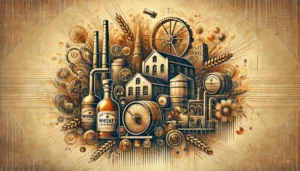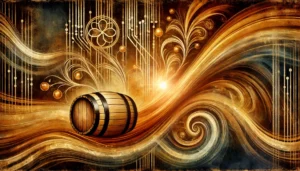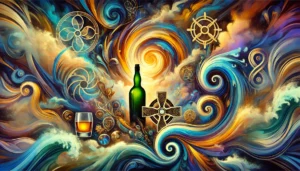In the rolling green landscapes of medieval Ireland, a remarkable tradition was brewing. Irish whiskey, now celebrated worldwide for its smooth, distinctive flavour, has its roots deeply embedded in the medieval era. This golden spirit was not just a mere drink; it was an integral part of Irish culture, a testament to monastic ingenuity, and a cherished commodity that traversed seas and borders. The story of Irish whiskey during the medieval period is not just about the evolution of a beverage; it’s a fascinating journey through time, capturing the essence of a society where tradition and innovation walked hand in hand.
Our exploration begins in the hallowed halls of monasteries, where the art of distillation was more than a process—it was a form of alchemy. These religious sanctuaries were the birthplace of Irish whiskey, where monks harnessed the secrets of distilling, transforming basic ingredients into a liquid that would become synonymous with Irish heritage. From the selection of grains to the mastery of the still, the production of whiskey in medieval Ireland was a craft honed over centuries, revered and refined in equal measure.
As we delve into the heart of this story, we uncover not just the methods and ingredients that shaped Irish whiskey, but also the societal fabric it was woven into. Whiskey in medieval Ireland was more than a drink; it was a social lubricant at gatherings, a medicinal potion, and a valuable trade commodity. Its consumption patterns reveal much about the social structures and customs of the time, offering a window into the everyday lives of the medieval Irish people.
In “Medieval Mastery: The Untold Story of Irish Whiskey’s Beginnings,” we journey through the misty annals of history to uncover the untold story of this beloved spirit. From its monastic origins to its rise as a symbol of Irish identity, this tale is steeped in history, flavoured with intrigue, and aged to perfection in the barrels of time. Join us as we trace the steps of medieval masters and uncover the legacy that has shaped Irish whiskey into the world-renowned drink it is today.
Monastic Mastery: The Birthplace of Irish Whiskey
In the Middle Ages, the foundations of Irish whiskey were laid in a rather serene and sacred setting: the monasteries. Irish monks, widely travelled and knowledgeable, brought back the art of distillation from their sojourns abroad, primarily from the Mediterranean regions. This technique, initially intended for perfume and medicinal elixir production, soon found a new purpose in Ireland – the distillation of whiskey.
The Early Distillers The monks were the early distillers. Their monasteries, scattered across the lush Irish countryside, became the cradles of whiskey production. Using simple ingredients – barley, water, and yeast – these monastic brewers began crafting a beverage that captured the essence of the land and the spirit of its people. The process was rudimentary yet innovative, employing basic stills that would later evolve into more sophisticated apparatus.
Distillation Process The distillation process in these medieval monasteries was an art. The monks would malt the barley, allowing it to germinate, and then dry it to halt the process, often using peat, which imparted a distinct flavour. This malted barley was then mashed, fermented, and finally distilled. The resulting spirit was potent and unaged, far from the smooth whiskey we know today, yet it was a cherished creation.
Cultural Role This early whiskey played a significant role in monastic life. It was used as a form of medicine, believed to prolong life and cure a variety of ailments. Monks also offered it to weary travellers and pilgrims, providing comfort and hospitality. In many ways, this spirit was an extension of the monastery’s role in society – a source of solace and healing.
Skill and Knowledge Transfer The knowledge of distilling gradually spread beyond the monastery walls. As monastic communities interacted with local clans and tradespeople, the skill of whiskey making began to permeate Irish society. This transfer of knowledge laid the groundwork for what would become a quintessential Irish craft.
Evolution of Distilleries From these monastic origins, whiskey making slowly transitioned to a more commercial practice. The dissolution of monasteries during the Reformation forced former monks to apply their skills in a secular context, leading to the establishment of the first licensed distilleries in Ireland.
In essence, the monasteries of medieval Ireland were not just religious hubs but also the birthplace of a tradition that would define Irish culture for centuries. The whiskey they produced, a testament to their craftsmanship and ingenuity, was the precursor to a beverage now synonymous with Ireland itself.
Production Techniques and Ingredients of Medieval Irish Whiskey
The craft of making Irish whiskey in the Middle Ages was a meticulous process, deeply rooted in the natural resources and traditions of Ireland. This segment delves into the specific techniques and ingredients that were integral to producing the whiskey of that era.
The Art of Malting The first step in whiskey production was malting. Barley, the primary grain used, was soaked in water and spread out on malting floors to germinate. This process was crucial for converting the starches in the barley into fermentable sugars. Once germination was achieved, the barley was dried in kilns. In medieval Ireland, these kilns were often fuelled by peat, imparting a distinct smoky flavour to the grain, a characteristic still cherished in some modern Irish whiskeys.
Mashing and Fermentation The malted barley was then ground into a coarse powder, known as grist, and mixed with hot water in a process called mashing. This mixture, or mash, was stirred in large vats, allowing the sugars to dissolve into a liquid called wort. The wort was then cooled and transferred to fermentation vessels where yeast was added. The yeast played a critical role, converting the sugars in the wort into alcohol, resulting in a liquid known as wash, with low alcohol content.
Distillation: The Heart of the Process Distillation was the core of the whiskey-making process. The wash was heated in large copper stills. As it boiled, alcohol vapours would rise and condense into a liquid with a much higher alcohol concentration. Medieval Irish distillers would distil their whiskey multiple times to increase its purity and alcohol content. These early stills were basic compared to modern equipment but were effective in producing a potent spirit.
Aging: Not the Norm Unlike today, aging whiskey in barrels was not a common practice in medieval Ireland. The whiskey was often consumed young and was much harsher and more potent than the aged whiskeys we are accustomed to now. Aging in wooden casks, which imparts flavour and smoothness to the whiskey, was a practice that developed later.
Herbs and Flavouring While pure whiskey was common, some medieval recipes called for the addition of herbs, spices, or honey to flavour the spirit. This practice was particularly common in medicinal uses of whiskey, where it was believed that certain herbs could enhance the healing properties of the drink.
Consumption Patterns and Social Significance
Irish whiskey in the Middle Ages was not just a product of meticulous craftsmanship; it was a vital component of social life and cultural practices. This section explores how whiskey was consumed and its significance in medieval Irish society.
A Drink for All Occasions In medieval Ireland, whiskey was more than just a beverage; it was a symbol of hospitality and celebration. It was consumed during feasts, religious festivals, and fairs. Whiskey was an integral part of social gatherings, enhancing the spirit of camaraderie and festivity. Whether in the homes of the nobility or in common taverns, it brought people together, transcending social boundaries.
Medicinal Uses Beyond its role as a social drink, whiskey was also valued for its medicinal properties. It was commonly used as a remedy for various ailments, ranging from colds and flu to more serious conditions. The antiseptic properties of alcohol and the belief in the healing power of herbs, often infused in whiskey, contributed to its use as a folk remedy.
A Symbol of Status Whiskey also held a place of prestige in medieval Irish society. The quality of whiskey a person served was often seen as a reflection of their status. The nobility would have access to finer, perhaps aged or flavoured whiskeys, while common folk might drink a more basic, potent version. However, the universal appeal of whiskey blurred these social lines, making it a drink enjoyed by all.
Ceremonial and Ritualistic Use In some instances, whiskey played a role in ceremonial and ritualistic contexts. It was used in toasts to honour guests, in wedding ceremonies, and even in funerary rituals, symbolizing the cycle of life and death.
Economic Impact The production and consumption of whiskey also had economic implications. It was a commodity that could be traded, and its popularity helped stimulate local economies, particularly in rural areas where ingredients were sourced.
Trade and Spread: The Journey of Irish Whiskey Beyond Ireland
The popularity of Irish whiskey in medieval times was not confined to the shores of Ireland. Its journey beyond Irish borders tells a story of trade, cultural exchange, and the emergence of whiskey as a globally recognized spirit.
Irish Whiskey as a Trade Commodity In medieval Ireland, whiskey quickly became a valuable trade commodity. Its production in monasteries and later in rural distilleries created a surplus that was perfect for trade. Irish ports bustled with activity as barrels of whiskey were loaded onto ships destined for distant lands.
Trading Routes and Expansion Irish whiskey found its way across the seas through established trading routes. It reached Britain, mainland Europe, and even farther shores. Each new market introduced Irish whiskey to different cultures, where it was often received with enthusiasm. This exposure laid the groundwork for the international reputation Irish whiskey enjoys today.
Impact on Local Economies The trade of whiskey also had a significant impact on local economies in Ireland. It created a demand for Irish barley, water, and other ingredients, stimulating agriculture and ancillary industries. The ports where whiskey was traded became centres of economic activity, contributing to the prosperity of coastal towns.
Cultural Exchange The trade of Irish whiskey was not just a commercial activity; it represented a cultural exchange. It introduced aspects of Irish culture to new audiences, and in return, Irish distillers were exposed to new ideas and techniques, which influenced the evolution of whiskey production.
The Legacy of Trade The extensive trade of Irish whiskey in medieval times set the stage for its global presence in the centuries to follow. It became a symbol of Irish craftsmanship and culture, a product that spoke of the land and the people behind its creation.
Legacy and Evolution: Connecting Past and Present
The story of Irish whiskey is a tapestry woven through time, connecting the past to the present. Its evolution from the medieval era to modern times is a testament to the enduring legacy and adaptability of this cherished spirit.
From Monastic Beginnings to Global Fame The journey of Irish whiskey began in the monasteries of medieval Ireland, where monks first distilled spirits from malted barley. This craft, honed over centuries, laid the foundation for what would become a globally recognized symbol of Irish culture. As the centuries progressed, the methods refined, the tastes evolved, but the essence of Irish whiskey – its connection to the land and its people – remained unaltered.
Technological Advancements The industrial revolution brought significant technological advancements to whiskey production. The introduction of column stills allowed for continuous distillation, increasing efficiency and consistency in the whiskey-making process. These innovations led to a smoother, more refined product, helping Irish whiskey to gain international acclaim.
Surviving Challenges Irish whiskey’s journey was not without its challenges. Political changes, economic upheavals, and Prohibition in the United States led to a significant decline in the industry in the 20th century. However, the resilience and dedication of Irish distillers saw the industry survive and eventually thrive once more.
The Modern Era of Irish Whiskey Today, Irish whiskey stands as a fusion of tradition and innovation. Modern distilleries, while equipped with state-of-the-art technology, still honour the time-honoured methods and recipes passed down through generations. The rise in popularity of craft and artisanal spirits has further invigorated the industry, with a focus on quality, heritage, and storytelling.
A Legacy Continues Irish whiskey is more than a drink; it is a narrative of Ireland’s history, culture, and people. From its monastic origins to its current status as a globally celebrated spirit, Irish whiskey continues to embody the spirit of Ireland – resilient, dynamic, and ever-evolving.








Be First to Comment